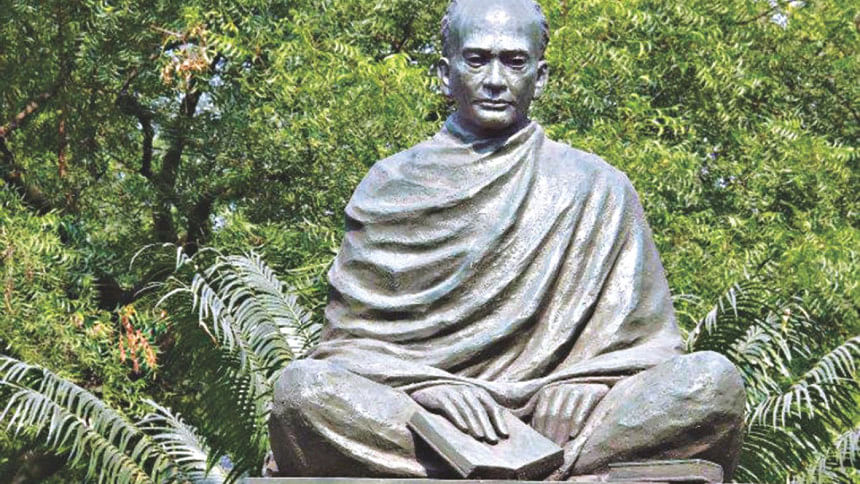Bengal's 'Ocean of Knowledge'


The Bengali Renaissance, a subject of heated debate among scholars and intellectuals, has been described sometimes as an intellectual reawakening, a flurry of cultural and artistic activities, a cognitive enlightenment, or as a middle-class revolution. There is no ubiquitous definition of what constitutes a renaissance, and therefore debates abound on whether what happened in Bengal in the late nineteenth century could actually be called one. But what is certain is that during the time, a number of creative figures, starting from Raja Ram Mohan Roy and till Rabindranath Tagore, did bring about a paradigm shift in the cultural and intellectual pursuits of Bengal and ultimately India. Of these illustrious figures, Ishwar Chandra Vidyasagar, holds a unique place — as a polymath, a philanthropist and a social reformer.
The persona of Vidyasagar has become an indelible part of Bengali history, so much so, that he has become now an almost legendary figure. Much of what is heard of him today in popular culture has taken on epic proportions. We know him as a scholar of indubitable genius, and as a proponent for women's rights. But, his contributions are sometimes shadowed by anecdotes, true or not: that, coming from a poor family, he studied under street lights at night, or how he taught himself to count from looking at mile posts on the road.
Born in 1820, Ishwar Chandra Bandyopadhyay, was given the title of Vidyasagar (ocean of knowledge) when he was merely twenty years of age. This reflected his extraordinary genius in academics – topping his class, and as a polymath, well learned in Sanskrit grammar, literature, rhetoric, the Vedanta, and even astronomy. But another aspect of his identity, as a philanthropist, is reflected by another popular name by which he is remembered even today – Danver Sagar (the ocean of kindness).
The contributions of Ishwar Chandra cannot be separated from his time. Subrata Dasgupta, in his book The Bengal Renaissance, writes that the "creative mentality of the Bengal Renaissance was dominated by two cognitive constructs: a cross-cultural mentality, and universalism." The author explains that at the time, in the context of the studies by the British orientalists on India's past, and exposure to western education, this mentality developed. We see during the 'renaissance' Ram Mohan Roy's contribution in the creation of the Brahmo Samaj, his efforts to eradicate the practice of sati in India. Michael Madhusudan Dutta would come to revolutionise Bangla literature with his sonnets and blank verse, while Jagadish Chandra Bose and Mahendra Lal Sircar would stand to disprove irrefutably the British view that Indians were incapable of scientific pursuits. Bankim Chandra and Rabindranath would pave the way for literature with their distinct contributions.

Compared to Ram Mohan's approach of creating a separate society (Brahmo Samaj) as social reformation to rid society of practices he condemned, Ishwar Chandra had a more inclusive approach. Arguably his greatest achievement was the role he played in the passage of the Widow Remarriage Act. Moved by the status of women, and especially the plight of widows who were forced to lead a life of imposed austerity, he campaigned for legal recognition of their right to remarry so that they could escape the conditions imposed on the grounds of family honour and reputation. In 1856, the act was passed, and later he would marry his only son to a widow. Here too his scholarship shone bright, for it was through the interpretation of religious texts that he sought to establish that there was no religious provision restricting remarriage of widows. As the Act read: "Whereas many Hindus believe that this imputed legal incapacity, although it is in accordance with established custom, is not in accordance with a true interpretation of the precepts of their religion, and desire that the civil law administered by the Courts of Justice shall no longer prevent those Hindus who may he so minded from adopting a different custom, in accordance with the dictates of their own conscience. . ."
In 1850, Vidyasagar would come to become the principal of Sanskrit College. Here too, he was a reformer and an educator. Till then only Brahman and Vaidya students were allowed to study at the college. Vidyasagar opened the opened its doors to all Hindus, introduced nominal tuition fees, and brought changes to the syllabus. His contribution to education went beyond that: he opened primary schools across Bengal and wrote text-books in his life-long effort to establish mass education. Of his lasting legacies is surely the Bengali alphabet, which he reformed, and much of which survives in the modern alphabets.
More critical historiography has however seen Ishwar Chandra and his contributions in a different light. While traditional interpretation has given emphasis on the man's spirit of charity, H N Goain wrote in the Social Scientist in 1979 how "recent accounts, inspired by revolutionary political views and haunted by the failure of the bourgeois-democratic revolution in India, offer an assessment of the man as a typical product of the 19th century 'Bengal Renaissance' and crippled by its inherent weakness: the insuperable limits of a class that had a vested interest in the colonial regime as its beneficiaries." Class-consciousness has undoubtedly played a major role in these views, and the renaissance was said to be little more than middle class aspirations. It is true that much of Vidya Sagar's work on social reformation was met with reluctance from the British who did not want to be seen meddling too much with local customs.

Another major criticism has been his supposed love for the British: he believed in gradual change and was not seen as a figure opposed to British colonialism in India. His programmes have also been criticised for lacking a significant political outlook which could liberate the peasantry. This is as much a criticism of the renaissance as of the man.
Whether one agrees if the late nineteenth to the early twentieth century in Bengal was a renaissance, it was a without a doubt a period of significant scientific, social and cultural ambitions and creativity. If we leave aside for a moment the definition of renaissance as what happened in Italy in the 12th to 14th century, we can appreciate more fully how historian Tapan Raychaudhury described the era: as "a seed time rich in possibilities." July 29 marks the 125th death anniversary of Vidyasagar. In commemorating his life and contributions, it is apt to remember him as a man who was not satisfied with intellectual solutions to problems, but was committed to put into practice what he believed.
The writer is a member of the editorial team, The Daily Star.

 For all latest news, follow The Daily Star's Google News channel.
For all latest news, follow The Daily Star's Google News channel. 



Comments